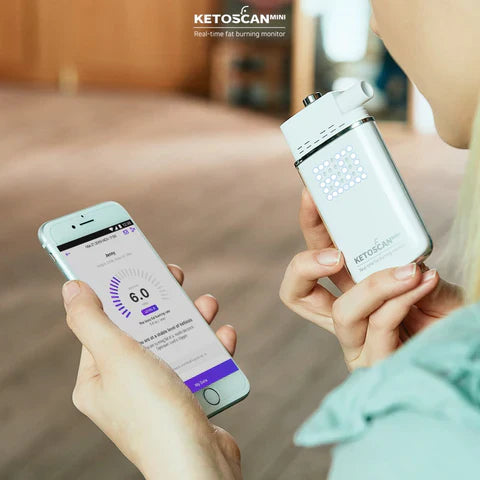How to Track and Measure Ketosis

Tracking and measuring ketosis is a valuable tool for ensuring you're on the right path during your ketogenic journey. While it's not mandatory, monitoring your ketone levels can help you fine-tune your diet, exercise, and lifestyle choices, especially when transitioning to fat adaptation. Let’s explore the tools, strategies, and best practices for tracking ketosis effectively.
Why Measure Ketosis?
The goal of a ketogenic diet is to transition your body into ketosis, a metabolic state where fat and ketones are the primary fuel sources instead of glucose. Tracking your ketone levels offers the following benefits:
- Validation of Progress: Ensure your efforts are leading to ketosis.
- Problem-Solving: Identify and adjust factors that might be preventing ketosis.
- Personalisation: Understand how your body responds to different foods, workouts, and routines.
- Efficiency: Speed up fat adaptation by knowing when you’re in optimal ketosis.
Three Methods to Measure Ketosis
Here are the three main tools for tracking ketone levels, each with its advantages and limitations:
1. Urine Ketone Strips (Keto Sticks)
What It Is:
Urine ketone strips are a simple, affordable tool to measure ketones in your urine. These strips change colour based on the presence of acetoacetate, a type of ketone excreted through urine.
How to Use:
- Collect a urine sample and dip the strip into it.
- Wait about 1 minute and compare the colour of the strip to the chart provided.
Why It Works (Physiology):
- Acetoacetate is one of the three ketones produced during ketosis. In the early stages, excess acetoacetate spills into urine, making it an easy indicator of ketosis.
- As your body becomes fat-adapted, it uses ketones more efficiently, reducing the amount excreted in urine, which can make this method less reliable over time.
Pros:
- Affordable (around $20-$30 for 50 strips).
- Easy to use.
Cons:
- Less accurate for long-term keto adaptation.
- Results may vary based on hydration levels.

2. Breath Ketone Monitors
What It Is:
A breath ketone monitor measures acetone, a ketone exhaled through your breath. This method is more accurate than urine strips and provides real-time feedback.
How to Use:
- Blow into the device, which measures acetone levels in your breath.
- The result is displayed on the monitor, indicating your ketone levels.
Why It Works (Physiology):
- Acetone is a by-product of fat metabolism and is expelled via the lungs. Measuring acetone provides a non-invasive way to track your body’s ketone production.
- As your body becomes fat-adapted, acetone levels correlate more closely with fat-burning activity.
Pros:
- Moderate price point.
- Non-invasive and reusable.
- Provides instant results.
Cons:
- Initial cost may be higher than urine strips.
- Slightly less precise than blood ketone meters.

3. Blood Ketone Meters
What It Is:
Blood ketone meters measure beta-hydroxybutyrate (BHB), the primary ketone circulating in your blood. This method is the most accurate way to monitor ketosis.
How to Use:
- Use a small lancet to prick your finger and collect a drop of blood.
- Insert a test strip into the meter and apply the blood sample to measure BHB levels.
Why It Works (Physiology):
- BHB is the most stable and abundant ketone in the bloodstream during ketosis, making it the gold standard for accuracy.
- Tracking BHB provides insight into how efficiently your body is using ketones for energy.
Pros:
- Highly accurate and reliable.
- Tracks the most physiologically relevant ketone.
Cons:
- Higher cost (around $70)
- Requires a blood sample.

When to Test Ketone Levels
To get meaningful data, it’s essential to test ketone levels at the right times:
-
Morning (Baseline Test):
- Test first thing in the morning after waking up.
- Your overnight fast allows you to measure ketones without interference from recent meals or activity.
-
Evening (Post-Day Check):
- Test at night to evaluate how your day’s choices (meals, exercise, etc.) affected your ketone levels.
- This can help identify foods or habits that may have knocked you out of ketosis.
Advanced Tracking: Glucose and Ketone Monitoring
For more precise data, consider using a glucometer that measures both blood glucose and ketones. This is particularly helpful for understanding how specific foods impact your blood sugar and ketosis.
Why It’s Useful:
- Determine how quickly your blood sugar returns to baseline after eating.
- Identify carb sources that work well for your body post-fat adaptation.
Optimising for Fat Adaptation
The purpose of tracking is to ensure you’re progressing toward fat adaptation. Fat adaptation occurs when you consistently remain in ketosis and your body efficiently uses fat for fuel. This process typically takes 4-6 weeks, depending on your consistency.
Signs You’re Fat-Adapted:
- Steady energy levels throughout the day.
- Reduced hunger and cravings.
- Improved mental clarity and focus.
Do You Need to Track Forever?
No! Once you’re fat-adapted, you can reduce the frequency of testing. Tracking becomes a tool for maintenance or when making significant lifestyle changes, such as trying new foods, workouts, or routines.
Key Takeaways
- Choose the Right Method: Urine strips are affordable but less reliable over time, while blood ketone meters provide the most accuracy.
- Test at Optimal Times: Morning and evening tests offer the most valuable insights.
- Use the Data: Adjust your diet, exercise, and lifestyle based on your results to maximise progress.
Pro Tip: Boost your keto journey with tools like our Keto Gummies Complete Set, designed to support energy, hydration, and ketone production.
Ready to optimise your keto experience? Explore our Keto Diet Guide for personalised tips, meal plans, and strategies to help you achieve ketosis and fat adaptation.

